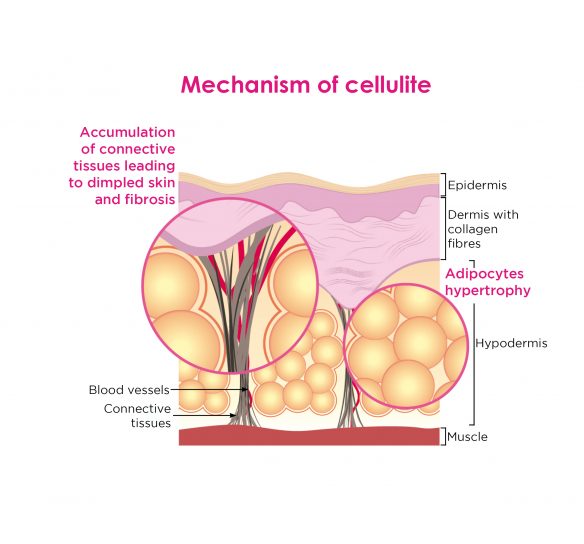Cellulite

A universal beauty concern
Cellulite is a structural and biochemical disorder of the fatty tissue, visually characterized by an uneven, dimpled skin surface: this is the infamous orange-peel effect.
With 85 to 90% of post-adolescent females concerned, whatever the geographical origin, dermatologists describe cellulite as a normal physiologic state in women1,2.
Although cellulite is not a serious condition from a medical point of view, it does represent the most widespread and undesirable aesthetic concern of women causing a poorly tolerated lack of aesthetics, discomfort, and a significant decrease in quality of life1.
85-90%
60%
49%
57%

Mechanism of cellulite
From a physiological point of view, cellulite refers to a protrusion of subcutaneous fat into the dermis, characterized by a visible modification of the skin topography1.
Cellulite is known to be linked to two main phenomena, both of which are closely related to a state of oxidative stress:
-Fat accumulation in adipose tissue conductive to adipocyte hypertrophy.
–Conjunctive tissue fibrosis
In some regions of the body, such as women’s hips and thighs, the specific morphology of fatty tissue promotes lipid storage, leading to tension forces within the fat lobules and oxidative stress.
This accumulation of fats and free radicals results in the destruction of collagen fibers and the development of fibrosis, which both limit the evagination of the fat lobules. The skin compartment bulges, leading to the noticeable “orange-peel” aspect of the skin1,4,5.
Dimpless®, first clinically proven oral ingredient for cellulite
A call for greater efficacy
Although a wide and varied range of mostly topical and mechanical anti-cellulite solutions is today available, very few of them are scientifically supported.
Cosmetics today available on the market, although abundant often disappoint users. For physical and mechanical treatments, besidesbeing invasive and expensive,there is a lack of evidence to support their beneficial effects.
According to experts, successful treatment of cellulite, a multifactorial disorder, ultimately involves a comprehensive multi-parametric solution.
Offering a systemic effect, nutricosmetics appear as a promising solution to this complex aesthetic concern.
